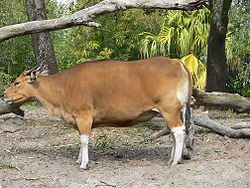Bos: Difference between revisions
+pl |
Prof. Finn (talk | contribs) No edit summary |
||
| Line 1: | Line 1: | ||
{{otheruses}} |
|||
{{Taxobox |
{{Taxobox |
||
| color = pink |
| color = pink |
||
Revision as of 20:47, 11 December 2006
| Bos | |
|---|---|

| |
| Banteng | |
| Scientific classification | |
| Kingdom: | |
| Phylum: | |
| Class: | |
| Order: | |
| Family: | |
| Subfamily: | |
| Genus: | Bos Linnaeus, 1758
|
| Species | |
|
B. acutifrons † | |
Bos is the genus of wild and domestic cattle or oxen. Bos can be divided into four subgenera: bos, bibos, novibos, and poephagus, but the distinction is controversial.
Biology and habits
Modern species of Bos are thought to have evolved from a single ancestor, the aurochs (B. primigenius). This particular species survived until the 1600s when it was hunted to extinction. There are about 1.3 billion domestic cattle alive today, making them one of the world's most numerous mammals. Members of this genus are currently found in Africa, Asia, eastern Europe and North America. Their habitats vary greatly depending on the particular species; they can be found in prairies, rain forests, wetlands, savannas and temperate forests.
Bos have a lifespan of 18-25 years in the wild, with up to 36 being recorded in captivity. They have a 9-11 month gestation, depending on the species and birth 1, or rarely 2 young in the spring.
Most species travel in herds ranging in size from 10 members into the hundreds. Within most herds, there is one bull (male) for all the cows (female). Dominance is important in the herds; calves will usually inherit their mothers spot in the hierarchy.
They are generally diurnal, resting in the hot part of the day and being active morning and afternoon. In areas where humans have encroached on the territory of a herd, they may turn nocturnal. Some species are also migratory, moving with food and water availability.
Most species are grazers, with long tongues to twist the plant material they favor and large teeth to break up the plant material they ingest. Many species are ruminant, having a four-chambered stomach that allows them to break down the tough plant material they consume.
Species
- Subgenus Bos
- Bos primigenius (aurochs) †
- Bos taurus (cattle and zebu)
- Bos aegyptiacus (Egyptian cattle; name not recognized by ITIS) †
- Bos acutifrons †
- Bos planifrons †
- Subgenus Bibos
- Bos frontalis (gayal or mithun, domesticated gaur)
- Bos gaurus (gaur or Indian bison)
- Bos javanicus (banteng)
- Subgenus Novibos
- Bos sauveli (kouprey or Grey ox)
- Subgenus Poephagus
- Bos grunniens (yak; also Bos mutus)
In 2003, the International Commission on Zoological Nomenclature "conserved the usage of 17 specific names based on wild species, which are pre-dated by or contemporary with those based on domestic forms", confirming Bos primigenius for the Aurochs and Bos gaurus for the Gaur.
References
- Briggs, H.M. and Briggs, D.M. (1980). Modern Breeds of Livestock. Macmillan Publishing.
- International Commission on Zoological Nomenclature. 2003. Opinion 2027 (Case 3010). Usage of 17 specific names based on wild species which are pre-dated by or contemporary with those based on domestic animals (Lepidoptera, Osteichthyes, Mammalia): conserved. Bull.Zool.Nomencl., 60:81-84.
- Van Vuure, Cis. 2003. De Oeros – Het spoor terug, Cis van Vuure, Wageningen University and Research Centrum / Ministry of the Flemish Community, Brussels & Wageningen.
- Zong, G. 1984. A record of Bos primigenius from the Quaternary of the Aba Tibetan Autonomous Region. Vertebrata PalAsiatica, Volume XXII No. 3 pp. 239-245. Translated by Will Downs, April 1991. Online pdf (62 kB)
